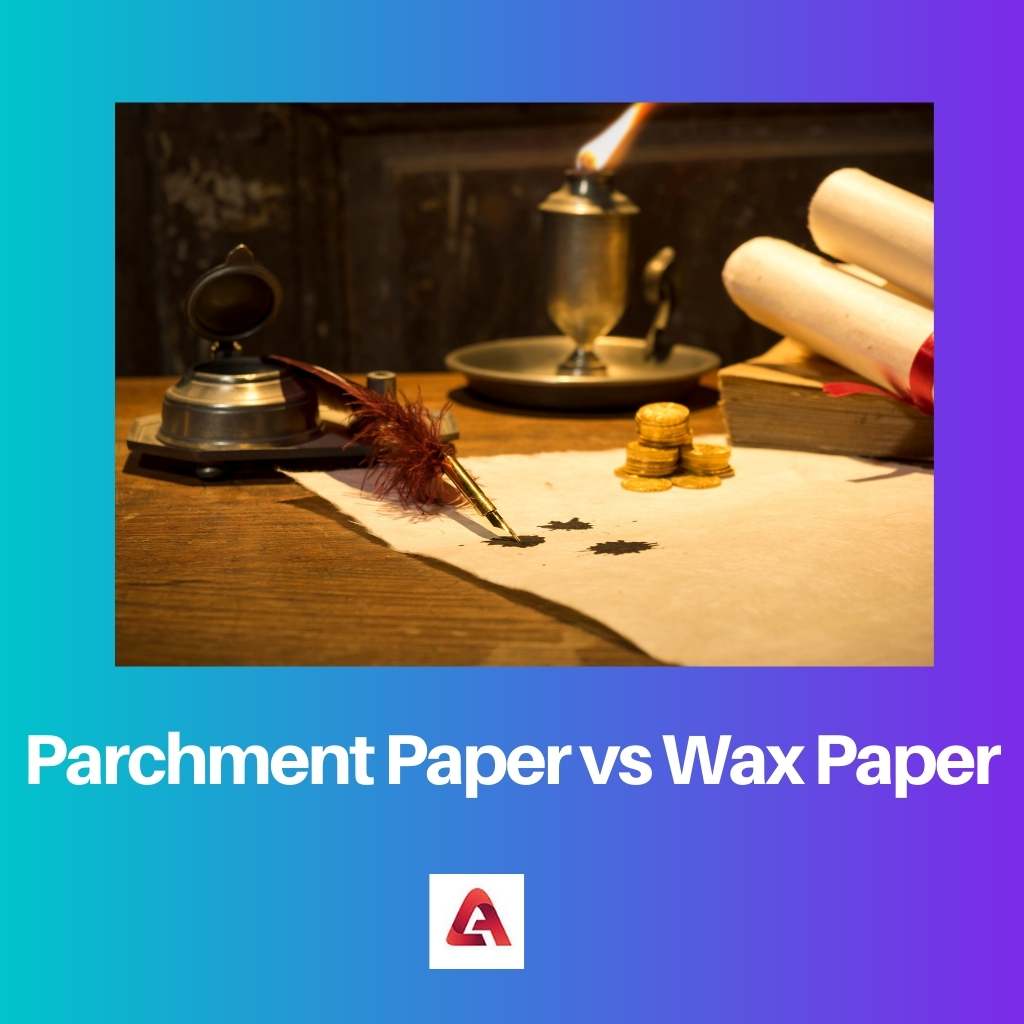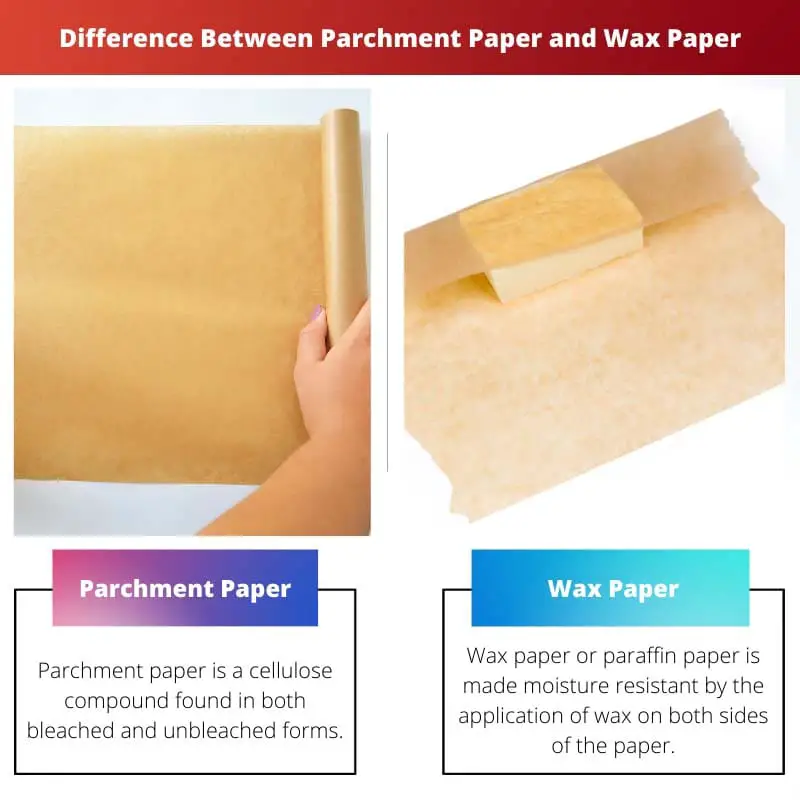When the days of the baking season start to approach, everyone must be wondering about the difference between parchment paper and wax paper and if one can be used if the other is not available.
Both these kitchen papers are excellent for cleaning up, wrapping food, and separating layers of food while storing them.
Key Takeaways
- Parchment paper is heat-resistant and non-stick, making it suitable for baking and cooking, while the wax paper is not heat-resistant and should not be used in the oven.
- Wax paper features a thin coating that provides a non-stick surface, whereas parchment paper is made from silicone-coated paper.
- Parchment paper is more expensive and versatile than wax paper, primarily used for food storage and preparation.
Parchment Paper v/s Wax Paper
Parchment paper is a type of kitchen paper that is coated with silicone, making it heat-resistant, non-stick, and ideal for baking. Wax paper is also a type of kitchen paper that is coated with a thin layer of wax, making it moisture-resistant, but it cannot withstand high heat and should not be used in ovens.

Parchment paper is a compound that goes through various processes to gain additional properties such as non-stickiness, moisture, grease, and humidity resistance.
The most common use of parchment paper is a disposable and non-stick material that prevents the food from sticking to the pan or tray and covering food to separate the layers between them.
Wax paper, or paraffin paper, is a paper-like material made moisture-resistant by applying wax on both sides.
The oiling or waxing of paper to make it moisture-resistant and semi-translucent has been practiced since the Middle Ages and was used on a large scale in the 19th century.
Comparison Table
| Parameters of Comparison | Parchment Paper | Wax Paper |
|---|---|---|
| Coated with | Parchment Paper is covered with a silicon coating. | Wax Paper is covered with wax coating on both sides. |
| Properties | Parchment paper is greatly resistant to heat, grease, moisture and is non-stick. | Wax paper is only moisture-resistant and non-stick. |
| Cost | Parchment paper is expensive. | Wax paper is affordable or cheap. |
| Durability | Parchment paper is durable and can be used again. | Wax paper is thin due to which it can’t be used again after being used once. |
| Usage | Parchment paper is used in baking and cooking. | Wax paper is used for wrapping food while storing or cooking in the microwave and covering countertops and tables. |
What is Parchment Paper?
Parchment paper is a cellulose compound found in both bleached and unbleached forms.
This paper is coated with a layer of silicon which makes the paper non-stick, as well as heat, moisture, and grease resistance, due to which it is greatly used while baking or cooking, and this layer is known as the greatest difference between parchment paper and wax paper.
When you have a roll of parchment paper inside your kitchen cabinet, there is no end to the list of things that need parchment paper.
The most common use in this list is lining the paper in baking trays or cake pans. Placing the parchment paper on the trays or molds acts as a non-stick surface that does not need any greasing, and the cookies or food can easily slide off the surface.
And if you are baking cookies in multiple batches, you can use the same paper again. Another great use of parchment paper is layering it between the cookies and candies to prevent them from sticking.
This paper also plays a vital role for culinary students, especially those who are learning to bake, as these students are required to specialize in creating decorations with chocolates that are used as garnish on pastries or piping letters on customized cakes.
Parchment paper also helps in keeping the counter clean. All you need to do is stick the paper all above the countertop and forget about the hardship of cleaning stains.

What is Wax Paper?
Wax paper or paraffin paper is made moisture-resistant by the application of wax on both sides of the paper.
The practice of applying wax or oiling the surface of the paper to make it moisture-proof and partially translucent has been exercised since the middle ages.
This paper, filled or layered with filtered beeswax, was greatly used in the 19th century to retain or block moisture or to wrap fragrant things.
In 1851, Gustave Le Gray introduced waxed papers for the negatives of photographs. Other than that, this paper is commonly used while cooking as it is non-stick in nature, which prevents the food from sticking or wrapping food to keep the moisture out.
Even though wax paper is greatly used while cooking, it is not recommended for baking in the oven, as it can get heated very quickly, burn, and explode too.
Wax papers are used in microwaves to avoid the food being splashed by covering the pan in microwave cooking.
Since wax paper remains unaffected by the heat of microwaves, it will not heat to the extent of burning under the heating temperature of the microwave.
This property of wax paper keeps it ahead of plastic wraps, which are more likely to burn in microwaves, or aluminum foil, which is considered dangerous for most microwave ovens.

Main Differences Between Parchment Paper and Wax Paper
- Parchment paper has a layer of silicon on both sides whereas, the wax paper has a layer of wax on each side.
- Parchment paper is heat resistant, whereas wax paper is not heat resistant.
- Parchment paper is specially created for oven use and is grease and moisture-proof, whereas wax paper can be used in microwaves and is moisture-resistant.
- Parchment paper is used for lining trays and cake molds or wrapping meat, fish, etc., whereas wax paper is used for covering kitchen cabinets and countertops.
- Parchment paper is expensive, while wax paper is cheaper.
- Parchment papers are capable of being used again, while wax paper is not durable enough to be reused.

- https://www.cambridge.org/core/journals/mrs-online-proceedings-library-archive/article/lasertreated-parchment-paper-an-inexpensive-microfluidic-platform/04181CE73B749ACFAFFED1E670D5FB14
- https://iopscience.iop.org/article/10.1088/0960-1317/23/11/114016/meta